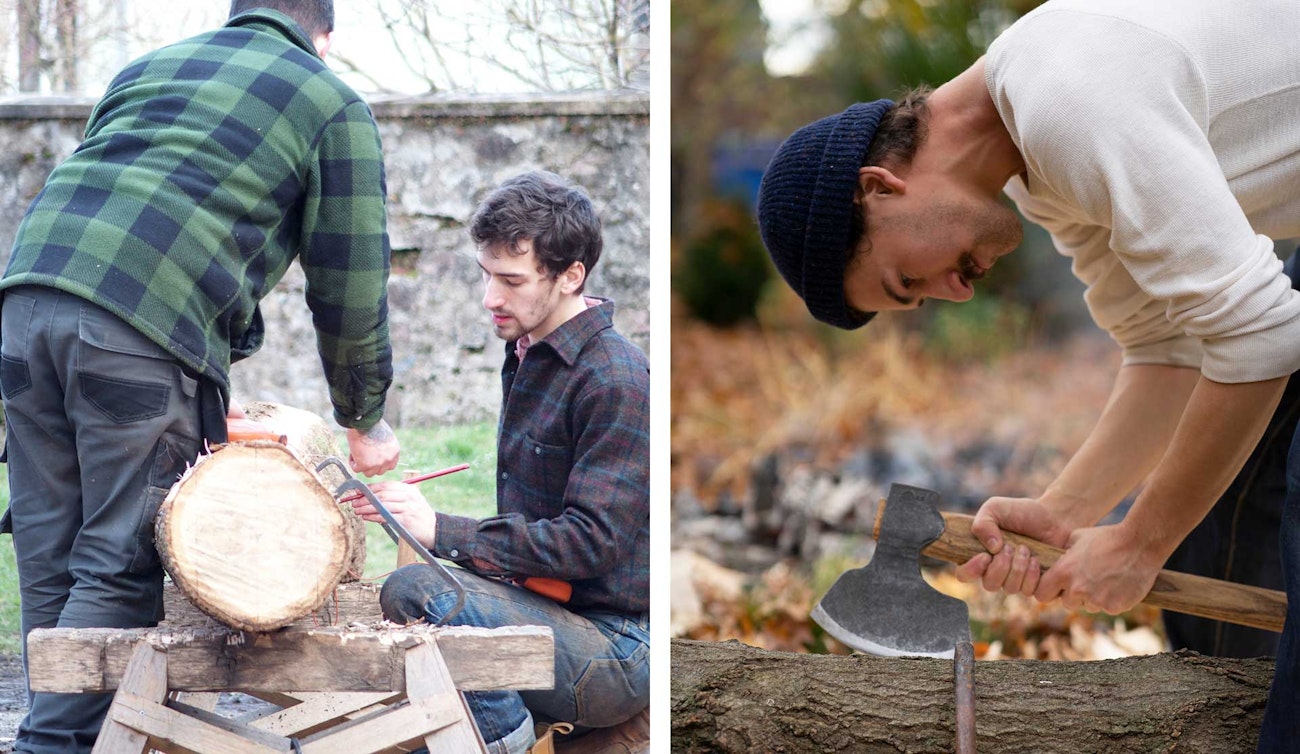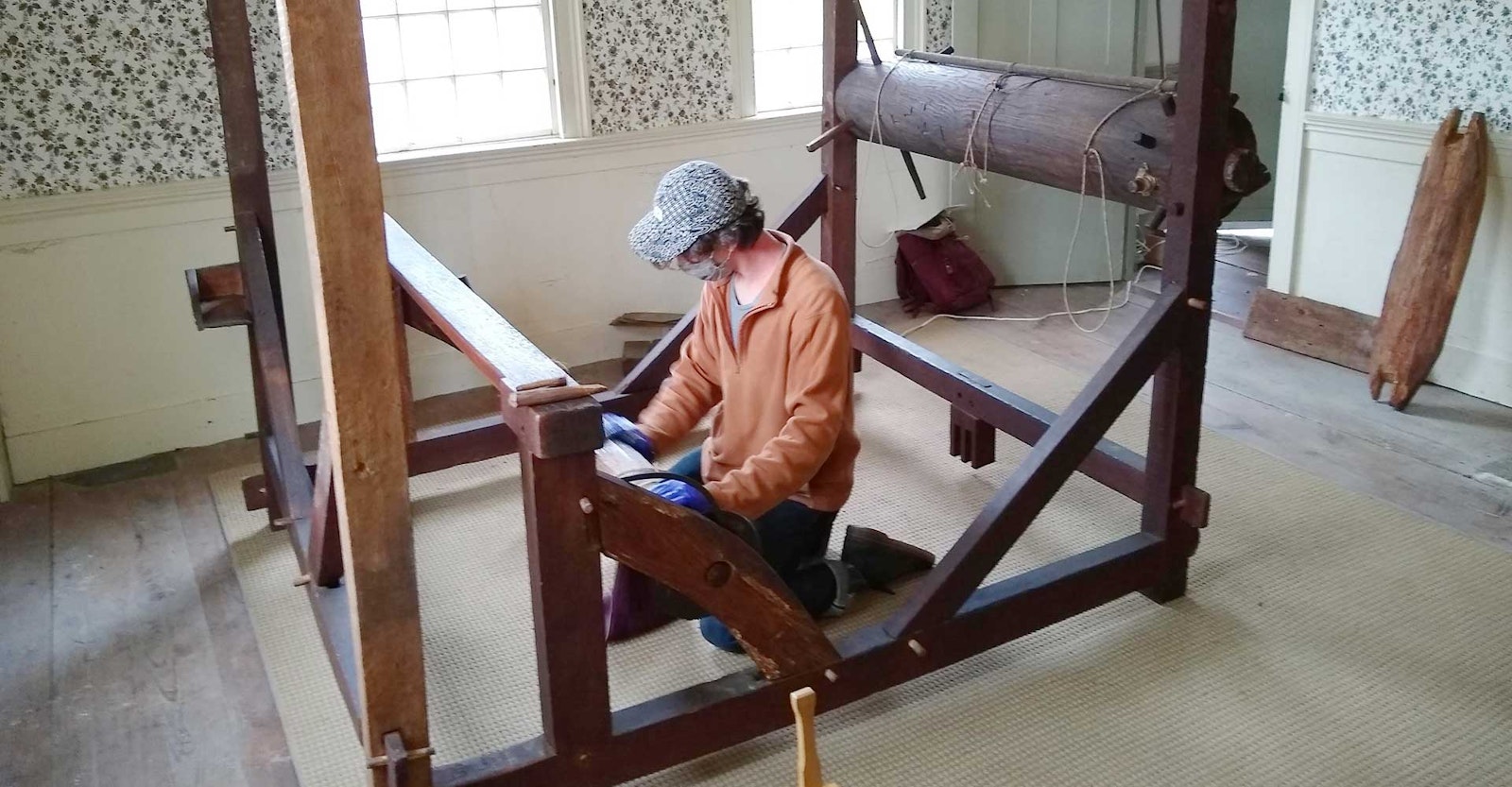When Nevan Carling looks at an old loom, he sees a miniature house, a microcosm reflecting the development of building traditions. Carling is a timber framer and carpenter who prefers traditional methods and hand tools.
Carling calls Hartford, Connecticut, home and is also a student of archaeology and heritage management at the University of York in England. When Kate Smith, director and head teacher at Marshfield School of Weaving, asked whether he would like to help with a research project called the Great American Loom Survey, he didn’t hesitate. As Carling likes to say, the project was perfect for somebody “young and spry.” Carling happily drove around New England and searched for old looms to record in exchange for weaving lessons when he delivered recovered looms to Marshfield.
According to Carling, the early looms still found throughout New England embody rather idiosyncratic timber-framing traditions. For example, in western Connecticut along the border with New York, you can find an amazing combination of Anglo and Dutch timber framing in both the houses and looms from the eighteenth and nineteenth centuries. While most houses from those centuries are gone, several looms remain.
“To be able to see, on a micro level, the creation of a New World style of timber framing, a wholly American style, is very interesting to me,” he said.
Carling was given his first loom in 2019 and started restoring it the following summer when the pandemic forced him to return home from study abroad. His mother is a knitter and the owner of the Village Wool Yarn Shop in Glastonbury, so the idea of creating cloth with yarn wasn’t unfamiliar to him.
The Beginning
His story really began, though, when he was 13, about six years before acquiring that first loom—and, yes, that makes Carling 20 now, but don’t let his age fool you.
“At 13, I got interested in blacksmithing and was given a forge and anvil,” he said. Not surprisingly, his Hartford neighbors were unhappy about the open flame and loud clanging in his backyard. The next year, he tried building his own blacksmithing workshop. He set to work using hand tools he had found and restored and quickly discovered he was a much better woodworker than blacksmith.
“As I started to learn more about woodworking traditions and timber framing,” continued Carling, whose father is English, “I realized I saw myself in the development of New England timber-framing styles from the seventeenth to eighteenth centuries: an English skeleton on the inside, but wholly American facade on the outside. It was a way to connect with my father’s side of the family, being able to look at buildings and say, ‘This is a part of my heritage, and I really want to preserve that heritage.’”
Supporting his interest, Carling’s parents dropped him off in Latvia for an intense timber-framing course when he was just 16. Carling helped build two houses while he was there, giving him solid foundational knowledge.
When he returned to the United States, he applied that knowledge to his own building projects while also working on a team preserving old houses. In a few years, he was off to York to start university. Being so close to continental Europe, he got involved with Carpenters Without Borders, which enabled him to learn continental hewing techniques.
Then the pandemic brought him home to Connecticut.
A Grand Discovery
In the process of restoring his loom that summer, Carling contacted the Marshfield School with questions. That conversation led to his work on the loom survey, which he now intends to document in Mortise & Tenon Magazine, a publication focused on preindustrial woodworking.
As part of the survey, Carling contacted every historical society in Connecticut asking if it had an old loom. He ended up speaking with Carol Laun, archivist and curator for the Salmon Brook Historical Society in Granby, Connecticut. Laun told him the society had just been given a house on the historic Wilcox property. While cleaning it out, they found an old barn loom in the attic. At Laun’s invitation, Carling went to check it out.
“The Wilcox house is amazing,” Carling said. “It remained in the same family from 1819 to 2019.” The attic was filled with all kinds of weaving and spinning tools, including a warping board built into the queen posts of the roofing system. “It was a complete weaver’s workshop.”
Even more rare was the paper trail Laun found in probate records that may reference this loom. An 1801 entry from the ledger of Moses Godard, a weaver and the first proprietor of the house, shows a payment to Nahun (Nathan) Holcomb for “framing a loom and repairing his looms.”
The picture is complicated because the next owner of the house, Sadoce Wilcox, also appears to have been a weaver. Probate records show a loom listed in his 1833 inventory, in addition to those for his father and grandfather from 1777 and 1773. According to Laun, “The first Wilcox to come to the colonies in 1635 was a linen weaver.”
It is impossible to know whether this loom was the one Godard had built or one brought by the Wilcox family. However, based on construction methods and telltale marks Carling found, he said it very likely was built between 1801 and 1839. “These four-post-and-rail looms appeared around the end of the eighteenth century and continued into the nineteenth,” he explained.
Intrigued by the loom’s provenance and eager to document it, Carling agreed to restore the loom for display. He took it apart and then cleaned the wood with alcohol and oiled it with pine tar and turpentine before reassembling it. He carefully preserved any chalk counting marks he found on it, which probably were made by the last weaver to use it.
Low beams and a very steep staircase leading to the attic made it impractical for visitors to see the loom in its natural habitat, so Carling suggested the well-lit front parlor as an alternate exhibit location. He suspects the loom may have been moved there for weaving during summers based on his experience working in the attic in August.
The Great American Loom Survey has several goals, according to Carling, including learning more about who built the old looms. It seems probable the builder of this loom was Holcomb, and Carling, whose main interest is how the looms were built, thinks whoever built it was a timber framer.
“He uses a joint I only see in looms built by timber framers,” he said. It’s a hard joint to cut, so the person who built this loom was very skilled and thought about it the same way Carling does—as if the loom is really a tiny house.
Carling said he sees evidence of three types of Early American loom makers. First were weavers who built their own looms. They knew how a loom worked but were not great carpenters or blacksmiths, evidenced by the finishing and alignment of the wood and metal parts.
Second, there were joiners or fine woodworkers who created perfect, tight joints. They knew what a loom looked like and how it functioned but did not understand the stresses the loom would undergo. Their perfect tight joints would eventually blow out under weaving tension and beating.
Finally, in the case of the Wilcox loom, a timber framer appears to have worked closely with the weaver making sure to address particular requirements for the loom and the order in which parts needed to be made. For example, the loom must be framed before determining the correct arc for the ratchet and pawl. Carling can even imagine the conversations that took place.
“The weaver asks the timber framer, ‘Can you build a loom for me?’ The timber framer heads off to the sawyer to get offcuts,” Carling envisions.
“When the loom is assembled in a rough state,” he continues, “the timber framer and weaver pack it up and head to the blacksmith shop. So you have at least three people present: the blacksmith, the timber framer, and the weaver, all having a conversation about how best to fit all these things together so the weaver can produce cloth.”
Carling relates the interconnectedness of that process to his current journey. “I am quite stunned at how this loom has opened up opportunities not only for myself but for a lot of other people, like [those at] Marshfield,” he said.

Left: Carling began woodworking when he was just 13 years old. His passion for the craft led him to work with Carpenters Without Borders in continental Europe while on school breaks. Right: Carling finds he prefers traditional hand tools for woodworking. Photos by Rafael Franco
Looking Forward
“Loom timber framing brings me directly into the historic preservation of houses and working in Europe,” he said. He has also reached out to British timber framers about organizing a survey of British looms.
The archaeologist in him wants to create a typology of the movement of horizontal looms from their earliest appearance in England in the twelfth and thirteenth centuries to New World traditions. However, he has a few steps to finish first.
In September 2021 he returned to the University of York. For his senior dissertation, he wants to use the data collected for the Great American Loom Survey to create a publicly accessible map, pinning the looms by location and including details about each one. Already committed to completing his master’s degree at York, he sees this as an ongoing investigation that could take years.
Carling is also learning French. His work with Carpenters Without Borders set his sights on another dream: being part of the restoration of Notre-Dame de Paris.
“I don’t even have to touch any wood,” he said, bubbling with obvious passion. “If I could be accepted as a student on the project and just stand there, watching and learning from these French carpenters as they raise the new roof on the cathedral, that would be so amazing.”
With so many ambitions, Carling doesn’t expect to become a serious weaver, although he has managed to weave enough denim to have a pair of jeans made for himself. He said he may keep a loom warped for occasional shuttle throwing, but his focus will remain on the looms, how they were made, and the building traditions they represent.

